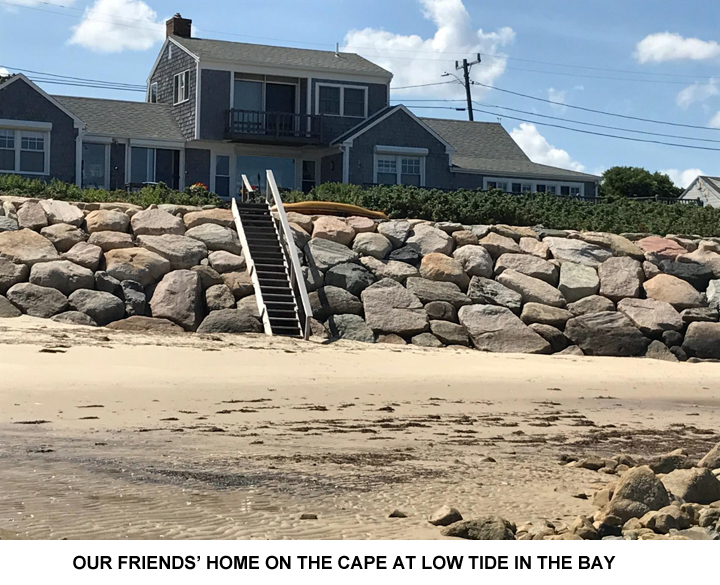
TRIP REPORT: LONG ISLAND, CAPE COD AND WESTERN NY STATE
We have just returned from a wide swing through Long Island, New England, and western NY state, a total of about 1500 miles and 8 days. We left on the 25th of August headed for The Cape, where old friends have a house on Cape Cod Bay; a primo location, to be sure.

Dave is a fanatical fisherman, and I enjoy fishing when I can’t go hunting, so I bought an outrageously overpriced MA non-resident 3-day license, for both fresh and salt water.
It’s a damned long drive from Blacksburg to The Cape so we decided to break it up. We stopped in Bethlehem PA to stay at a decent Marriott property, thence driving to and through NY City on the way. We went via the George Washington Bridge (or, in Noo-Yawk-ese, “Da George”) and the Cross Bronx Expressway to the Throgs Neck Bridge onto Long Island, headed for Orient Point via the Long Island Expressway. Here I have to pause and express my astonishment at the near-total absence of graffiti, even on the Cross Bronx Expressway. I never would have believed that this would be the case. I’m old enough to remember when NY City was more or less free of graffiti, a cancer that has spread all over the world; by the mid-1970’s every vertical surface in NY City was covered with it. But it seems that the Giuliani/Bratton policies of arresting and prosecuting taggers are still in force, or at least are remembered and feared by the would-be vandals who deface public property.
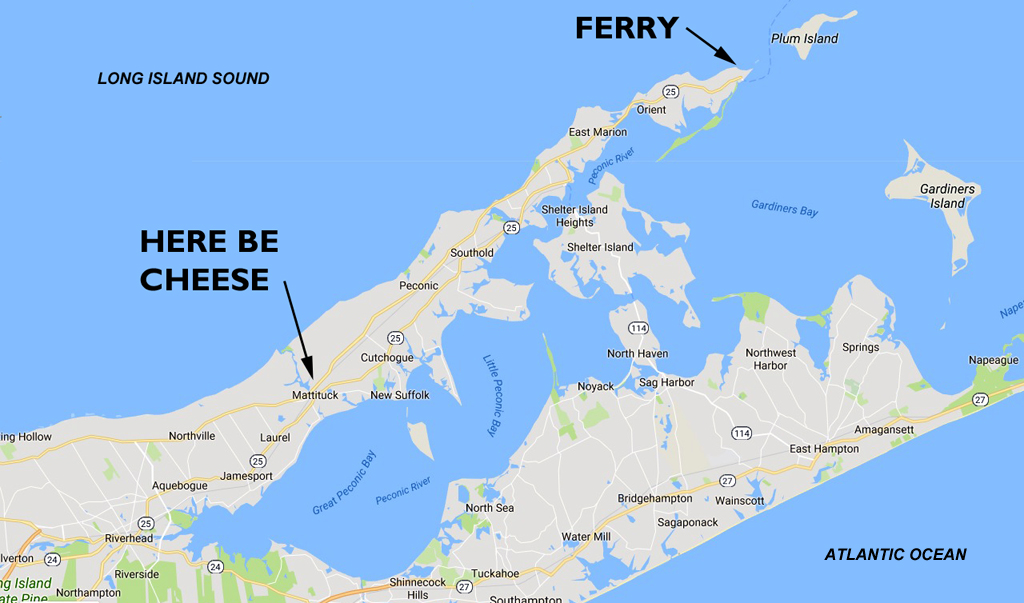
Orient Point is at the very tip of Long Island’s North Shore, where there are ferries to take you across the Sound to New London CT. Eastern LI is a wholly different place from the western end. At the west end you find Queens and Nassau County, but Suffolk County is rural and agricultural, looking nothing like the suburb of New York that it really is. In my youth LI was a prime producer of potatoes and ducks and even today if you buy a frozen duck in the supermarket it will invariably be labeled “Long Island Duckling.” White Peking ducks were introduced to LI in the late 19th Century, and duck farming so close to New York City took off in a big way; but ducks have all but disappeared as an item of LI agriculture. The term “Long Island Duckling” has come to be a generic for any eating-size domestic duck, no matter where grown. Ducks have been replaced by grape vines: LI is chock-a-block with vineyards and tasting rooms, not to mention farm stands where all manner of non-duck produce is sold.
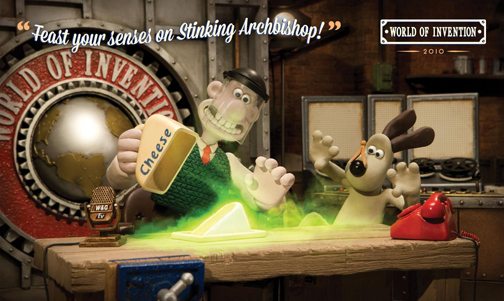 At the eastern end there’s a small village, Mattituck, with a first-class cheese shop. Years ago we bought some “Stinking Bishop” cheese there. If you’ve ever seen the animated “Wallace and Gromit” cartoons you’ll know that Stinking Bishop is cheese-mad Wallace’s favorite: the series made the cheese so popular that the one small cheese-ery (I have no idea what the term for a cheese-making place is) found demand far exceeding production capacity; but the owner (who might legitimately be called “The Big Cheese”) refuses to expand and more power to him for valuing quality over quantity. We were deeply disappointed to learn that Stinking Bishop is no longer imported to the US. It seems the Cheese Inspection Fascists in the USDA don’t like its bacterial content, so we on this side of The Pond are bereft of its charms forever. We found a sort of substitute and assuaged our hunger for Stinking Bishop with that and several other cheeses. Then on to the ferry.
At the eastern end there’s a small village, Mattituck, with a first-class cheese shop. Years ago we bought some “Stinking Bishop” cheese there. If you’ve ever seen the animated “Wallace and Gromit” cartoons you’ll know that Stinking Bishop is cheese-mad Wallace’s favorite: the series made the cheese so popular that the one small cheese-ery (I have no idea what the term for a cheese-making place is) found demand far exceeding production capacity; but the owner (who might legitimately be called “The Big Cheese”) refuses to expand and more power to him for valuing quality over quantity. We were deeply disappointed to learn that Stinking Bishop is no longer imported to the US. It seems the Cheese Inspection Fascists in the USDA don’t like its bacterial content, so we on this side of The Pond are bereft of its charms forever. We found a sort of substitute and assuaged our hunger for Stinking Bishop with that and several other cheeses. Then on to the ferry.
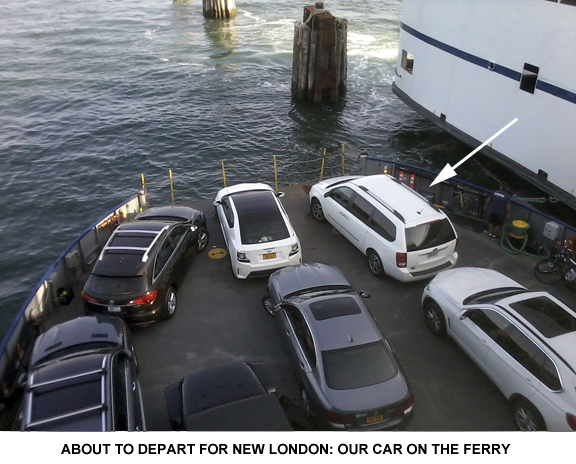 Actually we had originally planned an overnight stop in eastern LI for our second night but (as we later learned) some major golf tournament was being held and hotel prices were ridiculous. One Holiday Inn (a Holiday Inn, for God’s sake) wanted better than $1000 for a night’s stay! Most other places anywhere near Mattituck were way overpriced too, so we opted with some reluctance to stay in New London once we got off the ferry. All we could find was a “Red Roof Inn,” a motel in a chain so down-scale that even a Super 8 would have seemed like the Ritz in comparison. The place wasn’t exactly dirty, but neither was it sparklingly clean; and it cost us considerably more than the Marriott place in Bethlehem (which was sparklingly clean) had. But beggars can’t be choosers, so we propped a chair against the door—the other customers didn’t inspire much confidence about hotel security—and slept with one eye open. I’ll skip the details, but I’d never stay in a Red Roof Inn again if it can be avoided. It wasn’t the worst place we’ve ever stayed, but it was damned close.
Actually we had originally planned an overnight stop in eastern LI for our second night but (as we later learned) some major golf tournament was being held and hotel prices were ridiculous. One Holiday Inn (a Holiday Inn, for God’s sake) wanted better than $1000 for a night’s stay! Most other places anywhere near Mattituck were way overpriced too, so we opted with some reluctance to stay in New London once we got off the ferry. All we could find was a “Red Roof Inn,” a motel in a chain so down-scale that even a Super 8 would have seemed like the Ritz in comparison. The place wasn’t exactly dirty, but neither was it sparklingly clean; and it cost us considerably more than the Marriott place in Bethlehem (which was sparklingly clean) had. But beggars can’t be choosers, so we propped a chair against the door—the other customers didn’t inspire much confidence about hotel security—and slept with one eye open. I’ll skip the details, but I’d never stay in a Red Roof Inn again if it can be avoided. It wasn’t the worst place we’ve ever stayed, but it was damned close.
Then on to The Cape, with a side trip to Newport, Rhode Island to see a couple of the colossal mansions built by robber barons of The Gilded Age: most especially “The Breakers.”
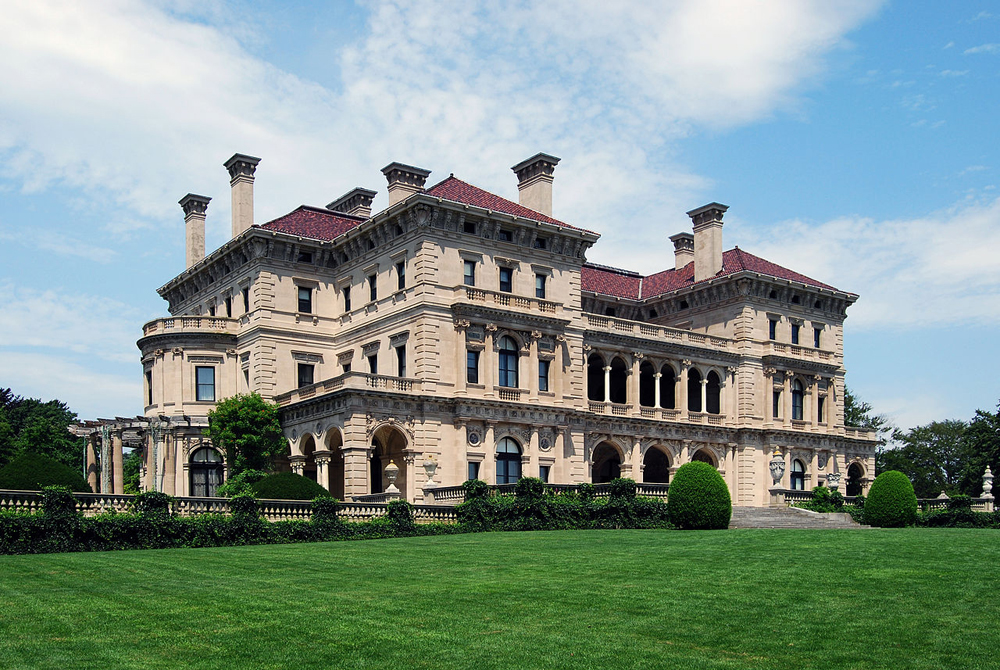
This is a stupendous house constructed by Cornelius Vanderbilt II who referred to that monstrous pile of masonry as a “summer cottage.” Needless to say his definition of a “cottage” doesn’t square with most people’s. Not unless you regard a 70-room palace that’s a monument to vulgar excess as a “cottage.” Vanderbilt’s hobby was building mansions: as big as The Breakers is, it’s much smaller than The Biltmore House in Asheville NC, which has 250 rooms! He also had a grand place in Hyde Park, NY next door to the Roosevelts (Imagine having FDR and Eleanor as poor neighbors).
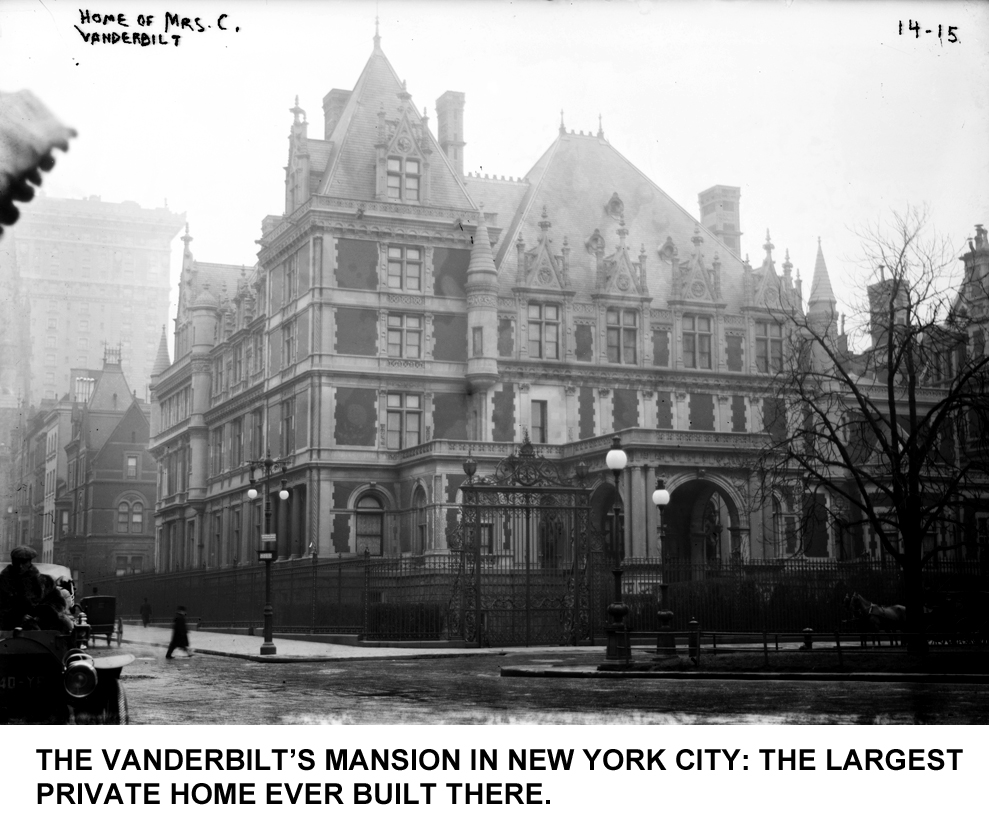
There were also a few homes in NY City (one of which was the largest house ever built in NY) and some more dotted here and there up and down the east coast. It just goes to show you that if you own all the railroads and steamship lines in the eastern USA and there’s no income tax…well, you can do whatever the hell you like. We were told by the tour recording that Vanderbilt found building these places “soothing” and that “…it took his mind off his business worries,” assuming a man that rich had any. By today’s standards, Vanderbilt could buy and sell Donald Trump or the average Saudi oil prince several times over. By the standards of 1893 he was unimaginably wealthy and I bet he was soundly hated for it, too.
We saw another mansion, one owned by Edward J. Berwind, who controlled the sales of coal to all the eastern railroads, the local industries, and the US Navy (at a time when coal fueled all warships). The name of this house—barely half the size of The Breakers—is "The Elms," though thanks to the Dutch Elm blight, there aren't any elms left. No doubt Berwind and Vanderbilt were good friends as well as business partners. He wasn’t in Vanderbilt’s league when it came to money (nobody before or since has been) but he wasn’t worried about his next meal, either.
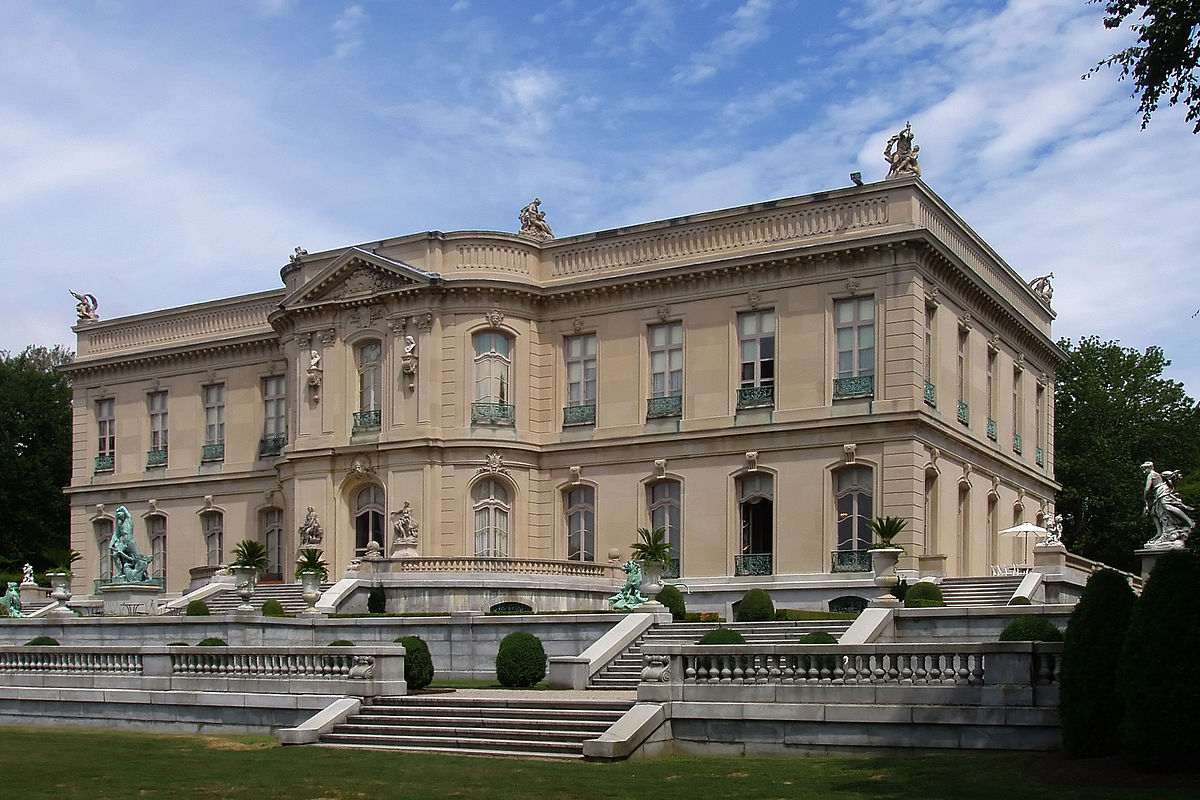
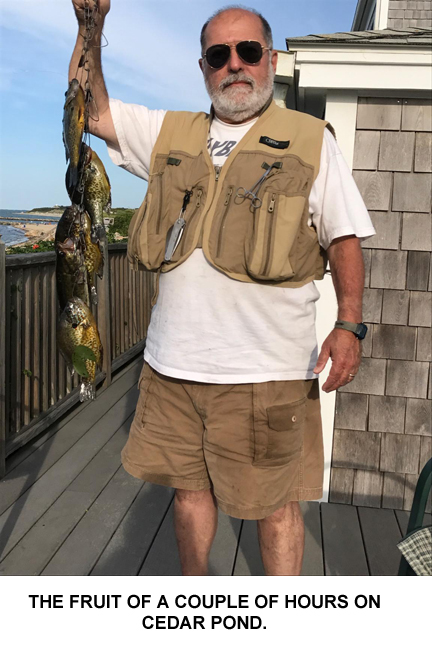 Then on to The Cape, arriving late in the day. The next day Dave and I went fishing in his two-man kayak. The first place we went was Cedar Pond, where we’d been some years ago and cleaned up. The Cape is riddled with fresh-water ponds, some of them stocked, some not: Cedar isn’t, but the fishing there is always good. In a remarkable burst of good sense (for MA) the ponds are public locations, and anyone can fish there, not just the wealthy people who own land around them. Now, I’m not built for a kayak and the older I get the less easily I get in or out of one, but once ensconced I was able to fish from it easily enough. I bought my old standby bait—nightcrawlers, which sell for only two-and-a-half times what they do in Virginia—but what did I expect? This was The Cape! I caught 5 nice fish: four slab-sided sunfish and a smallmouth bass. Those we had for dinner on the same night, cooked on Dave’s charcoal grill.
Then on to The Cape, arriving late in the day. The next day Dave and I went fishing in his two-man kayak. The first place we went was Cedar Pond, where we’d been some years ago and cleaned up. The Cape is riddled with fresh-water ponds, some of them stocked, some not: Cedar isn’t, but the fishing there is always good. In a remarkable burst of good sense (for MA) the ponds are public locations, and anyone can fish there, not just the wealthy people who own land around them. Now, I’m not built for a kayak and the older I get the less easily I get in or out of one, but once ensconced I was able to fish from it easily enough. I bought my old standby bait—nightcrawlers, which sell for only two-and-a-half times what they do in Virginia—but what did I expect? This was The Cape! I caught 5 nice fish: four slab-sided sunfish and a smallmouth bass. Those we had for dinner on the same night, cooked on Dave’s charcoal grill.
The second day was for salt water, so we launched the kayak into Cape Cod Bay, where we managed to avoid the sharks, and I caught nothing. Dave, however, caught two big striped bass, one of which served 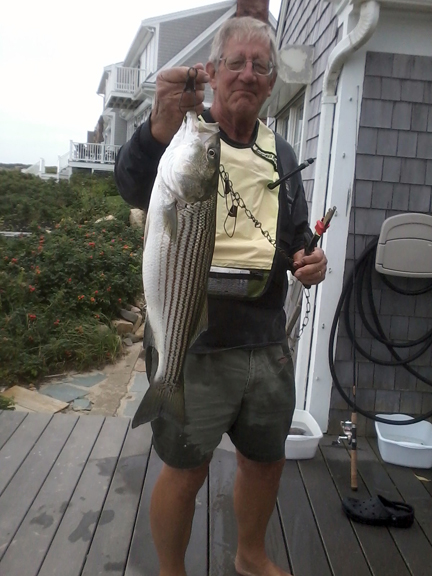 us for dinner the second night quite nicely. It was windy
us for dinner the second night quite nicely. It was windy 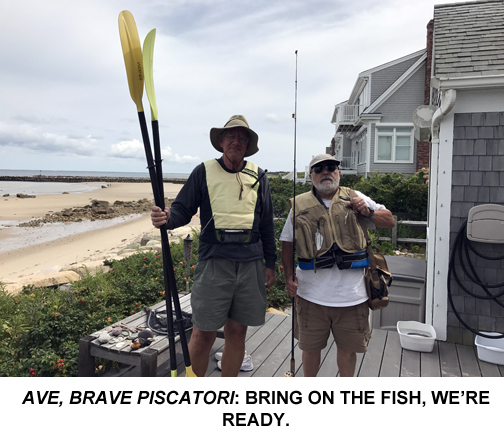 that day, and the water was a bit choppy, neither of which conditions are ideal for kayaking, but by Divine Intervention or the sort of luck that follows fools and fishermen, we stayed upright. The third day we tried briefly in an estuary, where I caught a 4” toadfish and one of those amusing puffer-fish, the kind that inflate an air bladder when they’re in danger. It was a Northern puffer, Sphoeroides maculatus. Though they’re rather cute, puffers contain tetrodotoxin, which even in extremely small doses is lethal to humans. Tetrodotoxin is 1200 times more poisonous than cyanide, so eating a puffer is a very bad idea. Then back to fresh water again at some other ponds with no results; in the end we bought oysters, clams and lobster rolls for dinner. One of the highlights of The Cape is the seafood. In southwestern Virginia we can get seafood but it’s been trucked in and is nowhere near so fresh as on The Cape.
that day, and the water was a bit choppy, neither of which conditions are ideal for kayaking, but by Divine Intervention or the sort of luck that follows fools and fishermen, we stayed upright. The third day we tried briefly in an estuary, where I caught a 4” toadfish and one of those amusing puffer-fish, the kind that inflate an air bladder when they’re in danger. It was a Northern puffer, Sphoeroides maculatus. Though they’re rather cute, puffers contain tetrodotoxin, which even in extremely small doses is lethal to humans. Tetrodotoxin is 1200 times more poisonous than cyanide, so eating a puffer is a very bad idea. Then back to fresh water again at some other ponds with no results; in the end we bought oysters, clams and lobster rolls for dinner. One of the highlights of The Cape is the seafood. In southwestern Virginia we can get seafood but it’s been trucked in and is nowhere near so fresh as on The Cape.
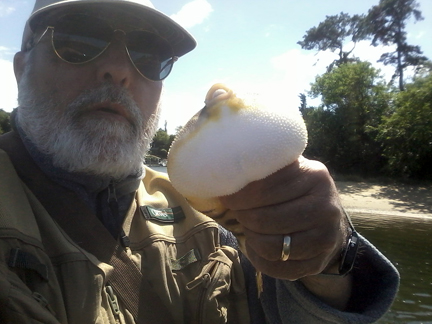 We had decided to visit my brother when we left The Cape. He lives in Pittsford NY, only 440 miles away, via I-90 across Massachusetts and the western tier of NY counties. The western end of The Empire State is as different from what most people think of as “New York” as chalk from cheese. Very rural and quite beautiful, it’s mostly dairy country and open farmland. The Finger Lakes near Rochester are especially beautiful wine country these days, so on departing from my brother’s house after a night’s stay we hit a tasting room for a winery on Canandaigua Lake. From thence we stopped at a golf and vacation resort in a setting of stunning beauty, the sort of place that is chosen for movie sets and gigantic society weddings.
We had decided to visit my brother when we left The Cape. He lives in Pittsford NY, only 440 miles away, via I-90 across Massachusetts and the western tier of NY counties. The western end of The Empire State is as different from what most people think of as “New York” as chalk from cheese. Very rural and quite beautiful, it’s mostly dairy country and open farmland. The Finger Lakes near Rochester are especially beautiful wine country these days, so on departing from my brother’s house after a night’s stay we hit a tasting room for a winery on Canandaigua Lake. From thence we stopped at a golf and vacation resort in a setting of stunning beauty, the sort of place that is chosen for movie sets and gigantic society weddings.
That part of NY state is dotted with small villages and towns, most of them quaint and lovely. One of the surprising aspects of the drive through that area was a near-total absence of fast food eateries and chain restaurants. I don’t think we saw even a single one, except perhaps a Subway in some medium-sized town. (I truly believe there’s a Subway in Antarctica, and I know there’s at least one in Russia because I’ve seen it.) But when we drove through those bucolic villages of perhaps 500 people, we saw only Mom-and-Pop custard stands and hot dog places. We ate lunch in a place called “The Roots” in the charming village of Naples, NY (Pop. 1041). It was seemingly run by women and for women: I was one of two males in the restaurant, so far as I could see. I have to say that it’s refreshing to find that there are still some places where the blight of standardized chains of fast food hasn’t taken hold. Not even a MacDonald’s marred the tranquility, so perhaps there is some hope for Mankind after all.
We spent the night in Lewisburg PA. Lewisburg and its environs are home to not one, but two federal prisons, one maximum security and one a prison complex that includes a minimum-security facility for “white collar” criminals. This last has been referred to in the press as a “country club” place but I suspect the “guests” at Allenwood don’t think of it as a club they’d voluntarily pay to join. The next morning headed down US Route 15, which has been vastly improved since the last time we drove across PA. It put us onto dear old I-81 directly and about 9 hours after leaving Lewisburg (including stops) we were at last home again.
| HUNTING | GUNS | DOGS |
| FISHING & BOATING | TRIP REPORTS | MISCELLANEOUS ESSAYS |
| CONTRIBUTIONS FROM OTHER WRITERS|
| RECIPES |POLITICS |